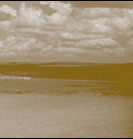| 3000 BC |
— |
The Ancient Egyptians are using two–handled ploughs |
| 2000 BC |
— |
| Farmers on the island of Crete are using ploughs with only one handle; the second hand is kept free to control the animals pulling it |
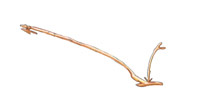
|
|
ploughs with one handle, 2000 BC
|
|
|
| 800 BC |
— |
Traditional scratch ploughs with an iron spike are being used in Mesopotamia |
| 500 BC |
— |
Seeder ploughs are being used in Mesopotamia (plough blades plus a seed hopper and mouldboard) |
| 100 AD |
— |
The Romans introduce the wheeled plough and rack (a cross–piece with iron teeth) to European farming |
| 1500 |
— |
Giovanni Cavallino (Italy) invents the first sowing machine of the modern age |
| 1665 |
— |
Joseph von Locatelli (Carinthia) links the plough to a sowing machine (sembrador) which plants the seeds a spoonful at a time |
| 1700 |
— |
The Flanders horticultural plough is developed with a concave mouldboard to reduce resistance |
| 1730 |
— |
Dutch blacksmiths develop an iron mouldboard with a screw–type winding mechanism in order to turn over the clods of earth completely |
| 1731 |
— |
Scotsman Jethro Tull advances the development of a sowing machine which will sow in rows: it is constructed in a similar way to an organ |
| 1763 |
— |
| In Scotland John Small builds the first plough made completely of iron |
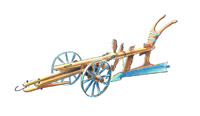
|
|
Württemberger plough, 1800
|
|
|
| 1800 |
— |
Newbold & Jefferson (USA) begin mass production of iron ploughs |
| 1830 |
— |
Ernst Alban (Germany) develops the first broadcaster |
| 1833 |
— |
John Lane develops the ploughshare made of mouldboard instead of cast iron |
| 1837 |
— |
| In the USA John Deere develops the first self–cleaning plough |
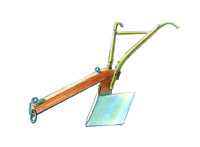
|
|
John–Deere–plough 1837
|
|
|
| 1841 |
— |
The Pennach brothers (USA) patent the first seed drill based on construction principles still in use today |
| 1850 |
— |
The Wanzleber plough is introduced for deep ploughing for growing sugar beet |
|
— |
Introduction of the seed drill to Germany |
| 1853 |
— |
In England William Smith builds the first working steam–powered plough (traction engine, plough, winch, controlled by ropes) |
|
— |
German inventor Wilhelm Siedersleben constructs the first seed drill for sugar beet |
| 1856 |
— |
John Fowler makes further improvements to the steam–driven plough: two traction engines on opposite sides of the field drive a cable winch which pulls a balance plough forwards and backwards across the field (the cable plough system) |
| 1900 |
— |
| The first potato harvesters are ready for mass production in Germany |
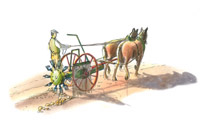
|
|
potato harvesters Neu–Ideal Germany 1900
|
|
|
| 1907 |
— |
In Germany the first motorised plough is developed by Robert Stock and Karl Gleiche |
|
— |
In Germany there are 2,239 steam–powered plough traction engines in use |
| 1911 |
— |
Mass production of tillage machinery (hay rakes, hay turners) starts at the International Harvester Company mbH in Neuss am Rhein with 700 employees |
| 1910 |
— |
The first prototypes of motorised tillers and motorised carrier ploughs are tested in Germany |
| 1922 |
— |
| Harry Ferguson (Ireland/Canada/USA) develops the three–point linkage for optimum power transmission from the tractor to the plough |
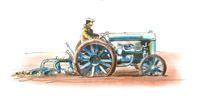
|
|
Fordson with three–point linkage, 1922
|
|
|
| 1957 |
— |
A drilling machine developed in Norway uses centrifugal force to distribute the grains – now it is possible to work fast and calibrate precise quantities of seed |







